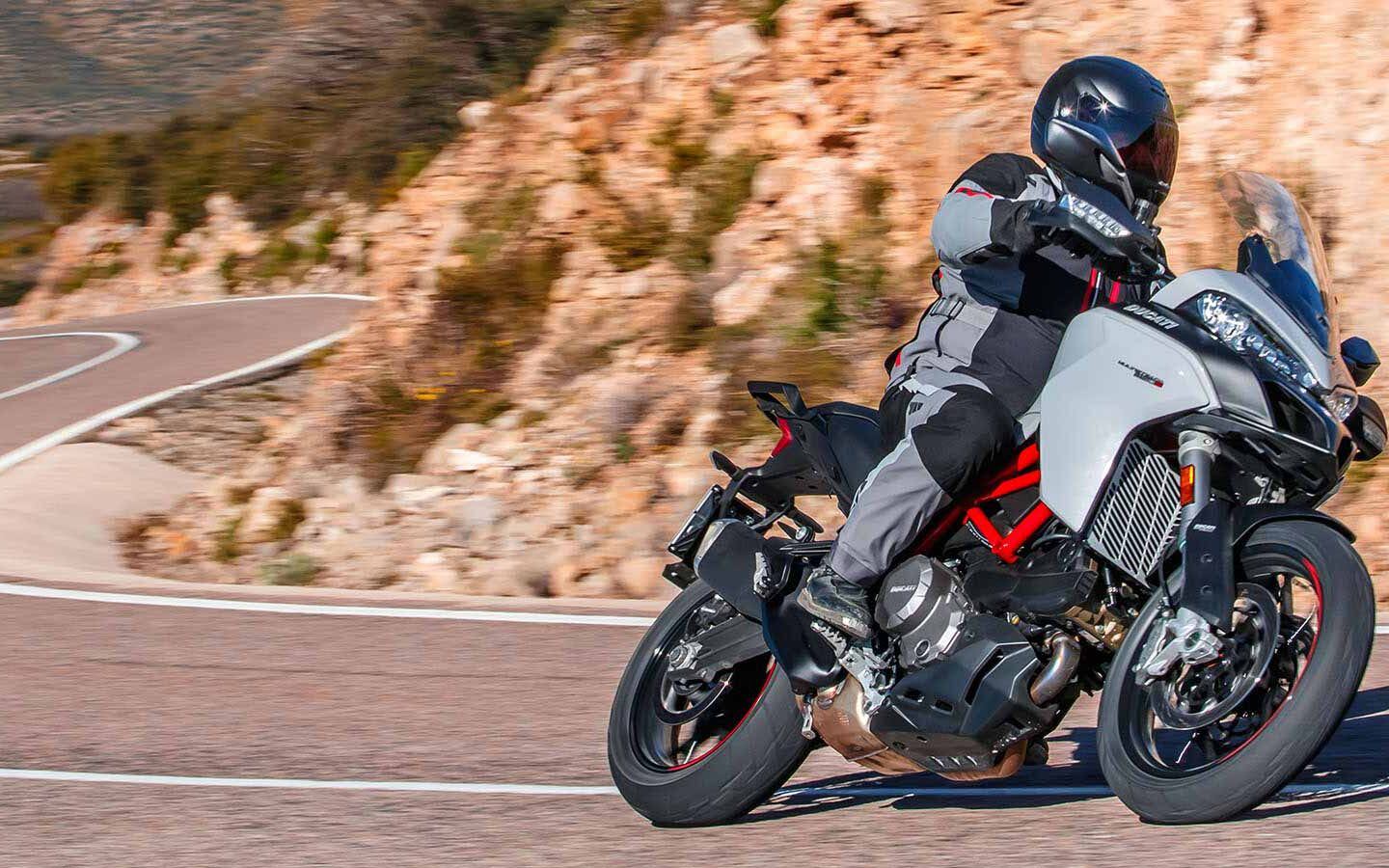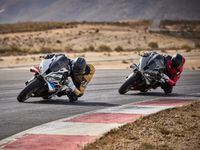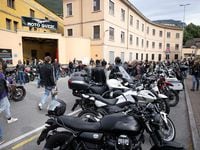For many years, motorcycles have been sold along a mostly unbroken continuum from smaller displacement with fewer features at a lower price, to bigger displacement with more features for a higher one. However, as any child who has eaten too many cookies can confirm, there comes a point of diminishing returns where more is not better.
A few years ago, 113 hp and 71 pound-feet of torque was considered strong, open-class performance, but no longer. In recent years, electronics and rider aids have pushed the limits of usable performance to new heights—Ducati's own 1260 Multistrada makes 158 hp and 95 pound-feet of torque. But out on the open road is more actually better? After riding the 950 S, I would say that answer is no.
Big news on the new Multistrada 950 S is the addition of a Bosch IMU, or Inertial Measurement Unit. The IMU enables all sorts of features like lean-sensitive ABS and traction control, to cornering lights that turn on when leaning. In addition, the bike has Ducati's Skyhook active suspension, which allows the rider to configure both preload and damping settings at the push of a button and then adjusts automatically on the fly. This system works very well in the real world and is a big improvement over the units fitted to the previous 950.
Continuing the theme of electronics, the bike now has cruise control—I used to scoff, but now I appreciate being able to maintain legal speed in places that my discipline might otherwise fail me. And like everything else these days, there are a bunch of selectable riding modes to choose between. There are several preset modes (Sport, Touring, Urban, Enduro), and within each one you can tailor the settings on engine output and responsiveness, traction control and ABS intervention, suspension damping and preload settings, and so on. There is also an app—not surprising when even coffee mugs connect to your phone—that allows you to create your own modes and download them to the bike, in addition to allowing Bluetooth connectivity once underway.
On the hardware side, the bike now has a quickshifter, combined braking, and a hydraulic clutch replacing the previous cable unit. The fuel capacity remains the same at 5.3 gallons, which offers about 200 miles of range in most conditions. There are several seat options to raise or lower, and a total of four optional packages available: Touring with luggage, heated grips, and a centerstand; Sport with an exhaust and some bling; Enduro with some protective bits; and Urban with a top case and tank bag. Cosmetics and ergonomics remain largely the same as the previous model (and very similar to the larger model). The bike has a 19-inch front wheel, which I think is an advantage on rough roads, whether they are paved or not.
Out on the road, the bike is exceedingly pleasant to ride. The suspension is much improved, and the electronic settings definitely translate to seat-of-the-pants feel. The softer settings are more compliant but let the bike dive and squat more, and the firmer ones keep the bike more level. The engineers did a good job of calibrating the system; when you select similar levels for both fork and shock, the ride is balanced. At the softest setting, the road feel was vague, but with a medium or firmer setting I could feel what the tire was doing. Another nice touch is that the settings are retained when you shut the bike off. Turn-in is sweet, and the bike strikes a nice balance between agility and stability. Cornering is more akin to a sporty naked than an adventure tourer. It holds a line with accuracy, which is something that can be hit or miss on most tourers with a 19-inch front wheel and a long(ish) fork.
The ergonomics are great—a seat that never made me squirm, and a windscreen that can be tuned on the fly to create reasonably quiet air. The riding position is excellent for seated touring but a bit odd for standing, which is fine with me. I like that the bike doesn’t pretend to be an off-road bike. A graded road here and there will be fine, but this isn’t intended as a rally bike and neither should it be.
The brakes are strong and progressive and have been updated this year. In addition to using cornering ABS, they are linked, so that both brakes are applied by the front lever. The components are excellent: Brembo Monoblock calipers grabbing 320mm rotors with a radial master cylinder. They say it has three levels of ABS, but I never tested that; whenever I wanted to slow down, the bike did exactly what I wanted with no drama. The latest generation of Pirelli Scorpion Trail II tires are impressive at generating grip without needing much time to heat up.
I was repeatedly struck by how strong the motor feels, even though I know a 1260 would leave it in the dust. The 950 motor is smooth from low rpm and provides plenty of power to make passing easy. The engineers say it delivers 80 percent or more of its peak torque from 3,500 to 9,500 rpm, and it feels like it—the power builds with rpm but it doesn’t always need a downshift to get away from a corner. Fueling was perfect, with no snatch when cracking the throttle, which used to plague fuel injection. For the loop we did in the hills around Valencia, Spain, I can’t think of a bike I would have preferred to ride. Bikes all have a character, and this one is friendly, capable, and undemanding, without being boring or bland. It feels like a Ducati, with a great connection to the road and a beautiful voice.
There are a few details that I didn’t like, none of which are very important. First, the US market will get only the spoked wheels, which are 11 pounds heavier than the cast ones. I think the spoked wheels look better, but after riding both options back to back, the additional rotating and unsprung weight is a drawback. The bike doesn’t respond as quickly in turns, and the suspension doesn’t follow the road quite as well. Second, the TFT dash is confusing at a glance, although with time it becomes easier to read. And finally, the bike has a hill control feature (which is fine) but it lasts only a few seconds, which becomes distracting at the moment you thought the bike was stable and suddenly it starts moving backward.
With all the features of the 950 S, the bike isn’t really on the usual line from small and simple to large and complex that we are used to. That makes it hard to choose a direct competitor. It isn’t like the BMW F850GS or KTM 1090 Adventure, neither of which has the same features nor the same focus. It is more like the Triumph 800 XR, which shares wheel size but lacks the IMU and has a very different character. In the end, I came away comparing it mostly with class-leading bikes—the Multistrada 1260 and KTM 1290 Adventure S in particular—and in some ways preferring it to either of those options. For one thing, I like to ride a slower bike faster, instead of the reverse. Making a few more shifts and leaving the throttle open longer is good fun in my view. Second, the combination of features is ideal—all the electronics with a 19-inch front wheel, without the bulk of the 1260 Enduro model. Finally, there is price: The 950 S in red rings in at $16,995, $4,000 cheaper than the base 1260. Gray is $200 more, but in either case, that’s a lot of bike for the price.
There is a good case to be made that too much is too much. This bike is just right for many of us. A temptation exists to imagine the bike is for novices or the less skilled because of the smaller displacement, but the reverse might be true—it can be even more capable for an expert because they can ride it more aggressively for longer. Although it is the entry-level Multistrada, the 950 S is anything but a beginner’s adventure-touring motorcycle.











/cloudfront-us-east-1.images.arcpublishing.com/octane/FQ36MWZH66UGPVGJJMBNVYLUOU.jpg)
/cloudfront-us-east-1.images.arcpublishing.com/octane/2QASEKUREOQZP4GTXJFJRD773I.jpg)
/cloudfront-us-east-1.images.arcpublishing.com/octane/QYIOXTZ5YMDQGYJEE4NRIGT4HY.jpg)
/cloudfront-us-east-1.images.arcpublishing.com/octane/HLVFEB22GYXITCJ6ED7M74QSIQ.jpg)
/cloudfront-us-east-1.images.arcpublishing.com/octane/J3F32IGU5QEIBKGIZSD5PNKOKM.jpg)
/cloudfront-us-east-1.images.arcpublishing.com/octane/6T63UYXOJTMA7W5NLW42CIQ5RA.jpg)
/cloudfront-us-east-1.images.arcpublishing.com/octane/OX6CKQAXMPVYIGJQM2SI5VPT44.jpg)
/cloudfront-us-east-1.images.arcpublishing.com/octane/5TIPO2ODCTPJQYQ7ZF4OQ4YAOA.jpg)
/cloudfront-us-east-1.images.arcpublishing.com/octane/WV5SKG7H2RKCIFLMMTAT23YI34.jpg)
/cloudfront-us-east-1.images.arcpublishing.com/octane/F3JAJHPWTQ444WGVAQUU6R5M4A.jpg)
/cloudfront-us-east-1.images.arcpublishing.com/octane/YMWAIPIPSJAOXOU3QMJMGH37OM.jpg)


/cloudfront-us-east-1.images.arcpublishing.com/octane/EJ6KZRGAYBCVXNL2PJXL37UVWQ.jpg)
/cloudfront-us-east-1.images.arcpublishing.com/octane/AAN4TI76M5H5JMUVEIGASWXBDU.jpg)
/cloudfront-us-east-1.images.arcpublishing.com/octane/P3RXD2UCPFF37CMB7CHPVKXORY.jpg)
/cloudfront-us-east-1.images.arcpublishing.com/octane/VZEG2EJI2RDFZNHLRZMU56MD3Q.jpg)
/cloudfront-us-east-1.images.arcpublishing.com/octane/GVJQO5FFOFBWNGODOBRB4FBAW4.jpg)
/cloudfront-us-east-1.images.arcpublishing.com/octane/BIVAK2SFIBDJJM25E7I5VU2FJE.jpg)
/cloudfront-us-east-1.images.arcpublishing.com/octane/CH5VX52UG5CFHOVH5A6UYEFWWA.jpg)
/cloudfront-us-east-1.images.arcpublishing.com/octane/ZVGJNGZRU5C33N7KN23BBFKSC4.jpg)


/cloudfront-us-east-1.images.arcpublishing.com/octane/CZ5OM3E43ZEXJHY7LCYXCHLIKI.jpg)
/cloudfront-us-east-1.images.arcpublishing.com/octane/DF5T4K5KPZFJXFCTGPYR77PKJM.jpg)
/cloudfront-us-east-1.images.arcpublishing.com/octane/RMCT2KVQBJHBZMRTSLOVPMOILU.jpg)

/cloudfront-us-east-1.images.arcpublishing.com/octane/K45KB2XHQVA65DX7VN4ZSMT2BI.jpg)
/cloudfront-us-east-1.images.arcpublishing.com/octane/FNHXQQ56BRD7TO4YIJ453PNG2M.jpg)
/cloudfront-us-east-1.images.arcpublishing.com/octane/OIKJC4JA3ZH7BMKUGWYKBIY5FA.jpg)
/cloudfront-us-east-1.images.arcpublishing.com/octane/MT2SAEWY6FDXFBYSLDE3AEFDTM.jpg)
/cloudfront-us-east-1.images.arcpublishing.com/octane/66UPKPYVURBPRCP5HXSN56MEMM.jpg)
/cloudfront-us-east-1.images.arcpublishing.com/octane/EOREGDSRKFDCRJC6K3EDVHBGCE.jpg)
/cloudfront-us-east-1.images.arcpublishing.com/octane/42RF63Q3LVCMBP3DGTWXFYSMOA.jpg)